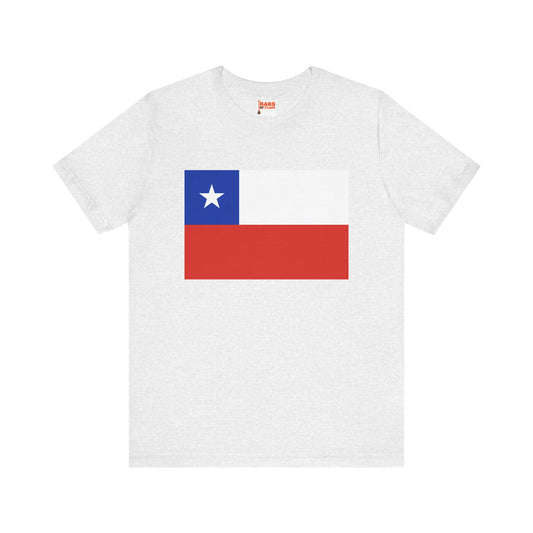-
Chile Leather Patch Hat
Regular price $18.85 USDRegular priceUnit price / per -
Chile Pillow
Regular price $22.65 USDRegular priceUnit price / per -
Chile Flag Sweatshirt
Regular price $34.15 USDRegular priceUnit price / per -
Chile Sweatshirt
Regular price $34.15 USDRegular priceUnit price / per -
Chile Hoodies
Regular price $34.40 USDRegular priceUnit price / per -
Chile T-shirts
Regular price $22.79 USDRegular priceUnit price / per -
Chile Flag Hoodies
Regular price $34.40 USDRegular priceUnit price / per -
Chile Flag on T-shirt
Regular price $22.79 USDRegular priceUnit price / per
Collection: Chile
The Chilean flag symbolizes pride and national identity for the people of Chile. With its striking design and vibrant colors, the flag powerfully represents the country's history and values. We will explore the Chilean flag's origins, symbolism, and current relevance.
Overview of the Chilean Flag

The flag of Chile, also known as "La Estrella Solitaria" (The Lone Star), features a distinct and meaningful design that distinguishes it from other national flags. The flag includes a blue square in the canton position, composed of two unequal horizontal bands – a white top half and a red bottom half. Within this blue square sits a solitary white five-pointed star. This design is meticulously proportioned, with the flag's overall dimensions following a 2:3 ratio.
The upper white band, symbolizing the snow-capped Andes, occupies half of the flag's total area, emphasizing the country's geographic and natural beauty. Meanwhile, the blue square and white star reside in the upper-left quadrant, creating a visual balance and focal point that draws the viewer's attention. The Chilean flag's precise layout and color scheme are visually striking and rich in symbolic significance, reflecting the nation's values, aspirations, and sacrifices made for its independence.
Historical Context of the Chilean Flag

The Chilean flag's design journey began amid the nation's quest for independence from Spanish
rule, culminating in its formal adoption on October 18, 1817. This pivotal period in Chile's history was marked by significant turmoil and a genuine desire for autonomy. The flag's inception was directly influenced by the era's spirit, with its creators drawing inspiration from the symbols of freedom and sovereignty evident in the flags of other revolutionary nations, notably the United States. The original design has undergone minimal changes since its adoption, primarily involving slight alterations in the shade of blue, demonstrating the enduring nature of its symbolism and the respect it commands within the nation.
The adoption of the flag closely followed the Battle of Chacabuco on February 12, 1817, a crucial victory in the Chilean War of Independence. This timing underscores the flag's representation of the country's physical features and values and its triumphant struggle for sovereignty and self-determination. The flag's design and colors were officially decreed by the government led by Bernardo O'Higgins, a central figure in Chile's independence movement, further cementing its role as a symbol of national unity and the triumph over colonial rule.
Symbolism of the Chilean Flag
The distinct colors and emblem featured on the Chilean flag carry deep symbolic significance, each element narrating a part of Chile's rich cultural and historical tapestry. The pristine white band vividly embodies the towering Andes Mountains, a geographical marvel and symbol of purity. Meanwhile, the deep blue square mirrors the expansive Pacific Ocean and the clear Chilean sky, central to the nation's identity and daily life. The vibrant red stripe powerfully conveys the bravery and sacrifice of those who laid down their lives for Chile's freedom, a reminder of the courage and resilience that paved the way for the nation's sovereignty.
At the heart of the flag, the solitary white star shines as a beacon of guidance, symbolizing the honor and progressive spirit that drives Chile forward. Together, these elements weave a narrative of unity, highlighting the Chilean people's shared aspirations and enduring strength. Through the flag, Chile commemorates its past struggles, celebrates its natural wonders, and looks with hope toward a future filled with achievement and prosperity.
Current Relevance of the Chilean Flag
Today, the Chilean flag plays a central role in embodying the nation's identity and unity. It waves prominently at public buildings, schools, and various national landmarks, serving as a constant reminder of the country's enduring spirit and values. The flag is a fixture at major events, including Independence Day celebrations, where it symbolizes the triumphs of the past and the hopes for the future. In international arenas, such as the Olympics or World Cup, the flag represents the pride and competitive spirit of the Chilean people, rallying them behind their athletes.
Military parades and ceremonies also feature the flag, highlighting the respect and honor attributed to those who serve and protect the nation. The flag's presence in these settings reinforces its role as a symbol of authority, resilience, and national pride.
While the Chilean flag is a source of unity, it has also been a focal point in political expressions and protests. In these contexts, it becomes a canvas on which citizens express their aspirations for social justice, democracy, and reform, illustrating the dynamic relationship between national symbols and the evolving aspirations of a country’s populace. This ongoing engagement with the flag underscores its significance as a historical emblem and a living symbol of the nation's continuing journey toward progress and equality.
Additional Facts About the Chilean Flag
Among the protocols associated with the Chilean flag is the unique practice that it should never be displayed in a position inferior to any other flag, emphasizing Chile's sovereignty and pride in its national identity. This extends to international events, where the Chilean flag must be flown at the same height as other nations' flags, with no distinction in the order of precedence, except when protocol dictates otherwise. Additionally, it is considered a grave disrespect to allow the flag to touch the ground or be used for commercial purposes without proper authorization, highlighting the deep respect that Chileans hold for their national symbol.
A lesser-known fact about the flag is its presence on every Chilean naval ship as a 'jack'—a small flag flown at the bow of the vessel, which underscores the flag's role in representing Chilean sovereignty across the seas. Moreover, during national celebrations or significant sporting events, it's common to see the flag displayed prominently on homes and public buildings, reflecting the unity and pride of the Chilean people. These practices and traditions surrounding the flag underscore its significance not just as a symbol of the nation’s past, but as a living emblem of its present and future.


















